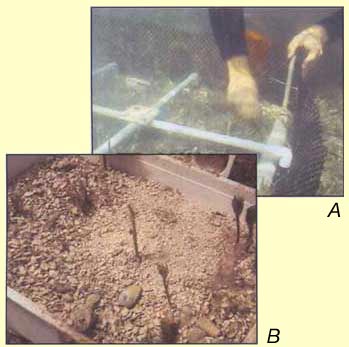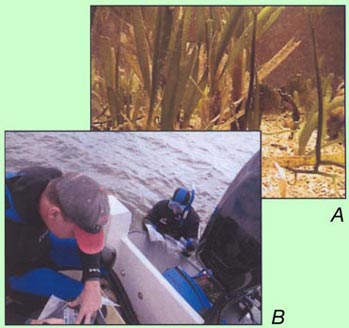
U.S. Geological Survey Fact Sheet 2004-3116
October 2004 - Online Version 1.0
Florida in a Tank—
The Role of Experiments in Ecosystem Restoration
Introduction
South Florida is undertaking a massive restoration effort under the Comprehensive
Everglades Restoration Plan (CERP), which was approved by Congress as part
of the Water Resources Development Act of 2000. The primary goal of the
CERP is to restore more natural freshwater flow through the South Florida
ecosystem. In the last century, changes in delivery of freshwater to the
estuaries of South Florida, including Biscayne Bay and Florida Bay, have
altered their natural patterns of salinity. Many detrimental environmental
effects, such as seagrass die-offs and loss of biodiversity, have been
blamed on changing salinity. The goal of the U.S. Geological Survey (USGS)
Ecosystem History Projects has been to identify natural cycles of change
prior to human alteration of the environment and to distinguish natural
change from anthropogenic change.
Understanding natural cycles of change
and the way a system originally functioned is essential to establishing
success criteria for restoration. Knowledge
about how human activities and natural fluctuations affect ecosystem change
can be obtained by observing potential cause-and-effect relationships in
the field, forming hypotheses, and then testing these hypotheses under
controlled conditions. If laboratory conditions faithfully replicate field
conditions,
then laboratory experiments can generate new hypotheses that can be tested
by field observations.
The USGS has replicated several South Florida ecosystems
in the USGS Leetown Science Center in West Virginia (figs. 1 and 2).
Through laboratory studies,
we hope to do the following:
- Develop new techniques for deriving water-chemistry
information from organisms that secrete calcium carbonate
- Apply these
techniques to document seasonal salinity changes during a century
or more
- Understand the effects of salinity and other ecosystem fluctuations
on submerged aquatic vegetation (including seagrass and macroalgae)
and associated
animal life
- Develop success criteria for CERP
 |
<--Figure 1. Map of the eastern United States showing the location of a study area
in Whipray Basin, Fla., and of the USGS laboratory at the Leetown Science
Center, Kearneysville, W. Va., where the Florida ecosystem has been replicated.
Photographs show the similarity of turtle grass (the seagrass Thalassia
testudinum) in both places. Base satellite image map from the National
Oceanographic and Atmospheric Administration, 2003. USGS satellite image
of South Florida from 1993. Photographs of turtle grass by J.B. Murray,
USGS.
--> Figure 2. Schematic diagram of the tank systems in the USGS Leetown Science Center
greenhouse. Control systems A and B reproduce the diversity
found in Florida Bay. Systems 1–8 are the environments for experiments.
|
 |
USGS Laboratory Systems
Culture and test systems in tanks (mesocosms) at the USGS Leetown
Science Center (LSC) were designed to replicate marine and estuarine seagrass
ecosystems typical of South Florida (fig. 2). The systems at the LSC are monitored
by using multiparameter water-chemistry sensors and data loggers (see box below).
To provide comparison data from the real world (fig. 3), these parameters are
measured at various sites in Florida Bay by water-monitoring stations installed
by Everglades National Park and the USGS. Data are stored at the loggers and
are downloaded to computers during periodic field visits.
 |
Figure 3. Comparison of water temperatures of tanks in control system A in the
USGS Leetown Science Center (fig. 2) with water temperatures from two data
loggers (A and B) in Whipray Basin, Fla. The example data from January
to May 2004 demonstrate that laboratory temperatures are very similar to
those in the study area, although they do not match the low temperatures
caused by storms. |
The success of the LSC laboratory systems is indicated
by the diversity of species that they support (figs. 4
and 5).
Currently, the LSC systems maintain over 200 species of
plants and animals, including
macroalgae, submerged aquatic angiosperms (true seagrasses),
many types of
calcareous algae, mollusks (snails and clams), echinoderms
(seastars, urchins, brittle stars), numerous cnidarians
(corals, anemones),
crustaceans, and
an array of worms of various phyla. Examples of experiments
conducted in the LSC mesocosms are provided in the boxes
below.
 |
<--Figure 4. Images illustrating the diversity of organisms in tanks in control
system A in the USGS Leetown Science Center (fig. 2). A, Two species of
anemones and several types of macroalgae. B, Several species of coral and
macroalgae. Photographs by W.B. Schill (A) and J.B. Murray (B), both of
the USGS.
-->Figure 5. Images of the diverse plants and animals in the USGS Leetown Science Center
mesocosms. The second photograph from the top is by W.B. Schill, USGS;
all other photographs in this figure are by J.B. Murray, USGS.
|
 |
|
Experiments on Organisms that Secrete Calcium Carbonate
Many organisms secrete calcium carbonate (CaCO3)
as they grow and thereby incorporate information about the water
in which they live. The proportions of elements in seawater (for
example, calcium, magnesium, barium, and strontium) are influenced
by salinity and temperature and are reflected in the composition
of calcium carbonate layers secreted by organisms as they grow (see
figure below). We can determine historical patterns of seasonal
temperature, salinity, and water-chemistry variability by analyzing
the elemental composition of calcareous shells, including those
of mollusks, ostracodes, and foraminifera, extracted from sedimentary
layers in shallow cores.
In order to interpret these data, we must understand the
biology of the living organism. What is its growth rate? What is
its life span? How do environmental variables such as salinity and
temperature alter the growth rate? Is growth constant? Laboratory
experiments using the LSC systems test the effects of various environmental
scenarios on the survival, growth, and reproduction of the shell-forming
animals mentioned above as well as algae that produce calcareous
skeletons. Examples of ongoing experiments include the following:
- Investigating the effects
of increasing salinity and temperature; the experiment reproduces
conditions caused by evaporation of warm bay waters
- Investigating the effects
of a rapid influx of freshwater; the experiment reproduces conditions
associated with a storm or the release of impounded
waters

Clams (Chione cancellata) being placed in
a study area in Whipray basin, Fla. (A), are the same species
being grown in the USGS Leetown Science Center (B). The water
chemistry at both sites is being monitored, and its effects on the
elemental composition of the calcium carbonate shells that the clams
are secreting will be determined; this information will calibrate
the standards used in interpreting paleoecology from buried shells
recovered in cores. Photographs by J.B. Murray, USGS.
|
|
|
Experiments on Seagrass
The die-off of seagrass beds is a worldwide problem and a critical issue
in any estuarine ecosystem because seagrasses are essential components
of those systems.
Seagrass meadows provide feeding grounds, nurseries, and habitats for many
forms of marine life, including such economically valuable species as shrimp,
lobster, and commercially harvested fish. They also are important foraging
sites for many species of migratory birds. In addition, seagrass beds anchor
sediments and impede sediment resuspension and coastal erosion during storms
and thus play a role in protecting other marine ecosystems, including coral
reefs. The immense surface areas of the seagrass plants and the sediments
underlying them (see figure below) harbor microbes that perform many
important functions, including nitrogen cycling, sulfur and metal reduction,
and metabolism of organic pollutants.
Seagrass beds are considered critical
habitats within the South Florida ecosystem, and many hypotheses
have been proposed to explain die-offs such as those that
occurred in Florida Bay in 1987–88, when about 18 percent of the beds were
affected. Unfortunately, seagrass biologists have lacked experimental
systems to test these
hypotheses under controlled conditions. As a result, the causes of these die-offs
and the factors that control the health and distribution of seagrasses remain
poorly understood. An understanding of these factors is essential if resource
managers are to prevent further losses and restore damaged systems. We are
using the culture and test systems at LSC and advanced molecular methods
to study
seagrass and to do the following:
- Identify disease agents associated with
seagrass die-offs
- Define the role of environmental stressors (such
as salinity fluctuations) in seagrass die-offs
- Investigate the role
of seagrasses in estuarine biogeochemical processes

Seagrass in control system A in the Leetown Science Center (A) and USGS scientists collecting samples of the sediment underlying seagrass beds in Whipray Basin, Fla. (B). Both the seagrass and the sediment harbor microbes that perform many important functions. Photographs by J.B. Murray (A) and W.B. Schill (B), both of the USGS. |
|
Importance of Experimental Studies in Restoration
Adaptation and selection of plants and other organisms
occur over biologically significant periods of time in
response
to natural
changes to the ecosystem.
Anthropogenic changes to the South Florida ecosystem
during the 20th century altered the natural patterns
of change.
As restoration
proceeds,
the natural
rates of change must be considered. If restoration induces
rapid rates of change to the ecosystem that exceed natural
rates of
change, then
plants and other organisms may not be able to adapt.
Results
of the experimental studies conducted in the mesocosms and results of
the advanced molecular analysis,
linked
to the ecosystem history studies,
provide insights into the rate of restoration that is
tolerable by
the system. These results will enable resource managers
responsible for implementing
the CERP to develop a model to predict future response
to restoration changes. The resource managers can then
set realistic
targets
and performance measures
for restoration. Knowledge gained from this study should
be applicable to
other estuarine ecosystems throughout Florida and the
Gulf of Mexico and, with modifications, to similar threatened
ecosystems around
the world.
What’s Next?
Current plans to utilize the USGS Leetown Science Center
mesocosms include the following studies:
- Investigations of reef-decline issues, such as coral diseases,
heavy-metal contamination, pesticide contamination, and coral genetics
- Identification of the effects of invasive species within the
marine and estuarine ecosystems of South Florida
- Extension of chemical analysis techniques to study the carbonate
structures of marine macroalgae
By James B.
Murray, William Bane Schill,
and G. Lynn Wingard
For more information on the mesocosms
and ongoing studies, please contact:
James Murray, jbmurray@usgs.gov
For more information on microbial and molecular studies,
please contact:
Bane Schill, bane_schill@usgs.gov
For more information on ecosystem history research in
South Florida, please
contact:
Lynn Wingard, lwingard@usgs.gov
http://sofia.usgs.gov/flaecohist/
U.S. Department of the Interior, U.S. Geological Survey
URL: https://pubsdata.usgs.gov/pubs/fs/2004/3116/fs2004-3116.html
For more information, contact James Murray, Bane Schill, and Lynn Wingard
Maintained by Eastern Publications Group
Last modified: 18:00:12 Tue 29 Nov 2016
Privacy statement | General disclaimer | Accessibility








